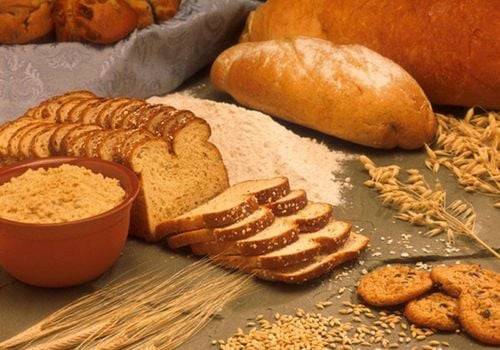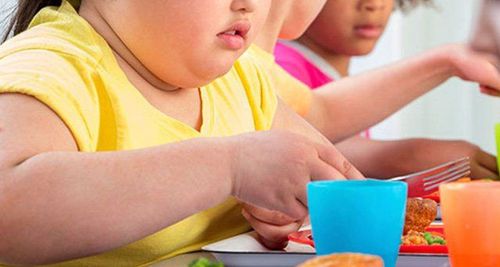This is an automatically translated article.
It can be difficult for your child to eat healthy while you are on vacation or participating in activities such as: practicing sports, going to school and doing household chores. Every parent knows how difficult it is to convince kids to eat more nutritious foods. To improve this situation, you can apply by encouraging children to be involved in the kitchen, you are helping them build a strong foundation for healthier food choices.
1. Plan your child's meals in advance
Whether you're eating on the go or eating out, you can find healthy foods for your kids (and for yourself) if you plan ahead. Try these first-and-forth strategies to improve your child's eating habits.
Make time for breakfast. Give your family a good start with the most important meal of the day. Breakfast enhances focus in the meeting room or classroom, can aid in maintaining a healthy weight, and provides the energy needed for morning activities. These tips can help you make sure breakfast is part of your child's healthy diet. Get ready the night before. You can put bowls, spoons, and boxes of cereal on the table the night before. Make simple dishes. If you or the kids aren't hungry in the morning, make breakfast small and simple. Eat a banana or apple with a handful of nuts, or open a small box of yogurt. Prepare something to take with you. You can use pre-sliced fruit and cheese in a plastic container, make a peanut butter and banana sandwich, topped with toasted bagels with hummus, or a smoothie fruit element. Grab some leftovers. A slice of veggie pizza is just as good for breakfast as it was the night before. So is a cup of pasta with grilled vegetables.
2. Friendly snacks
Pack healthy snacks that kids can manage on their own, including food that is past its shelf life and fresh. Healthy foods that are also kid-friendly can include:
Fresh, easy-to-eat products like apples, bananas and grapes Dried fruits like cranberries, raisins, apricots, apples and pineapples low-sugar granola Crackers with peanut butter Prepackaged cheese seasonings Disposable yogurt containers Easy-to-eat veggies like red peppers, carrots, or celery Dry cereal you've packed into a single-serving container eat Before eating out. You can have a plan ready and can easily find restaurants that serve healthy food for children. Focus on places with lots of healthy options like Asian restaurants, salad bars, and seafood places.

Tập cho trẻ ăn thức ăn lành mạnh với một số đồ ăn nhẹ thân thiện
3. Provide children with healthy options
What should children eat? Give a child a carrot for an afternoon snack and you may get a nasty reaction. Let your child choose between a carrot, mandarin or a handful of grapes and you'll likely get a much more vivid response. We all love choice, so whether at home or away, you can engage your child in healthier baby foods and enhance their diet by letting them make their own. Choose what your child needs to eat. Just make sure your child's choices are healthy choices.
At the restaurant. Next time you're at your favorite restaurant, give the kids a choice between two or three healthy options. Does your child want a grilled chicken sandwich or a simple burger? A side salad, baked potatoes or roasted corn? Fruit sorbet or frozen yogurt? Let the child choose. At home. Make eating healthier by starting with kid-friendly basics: Try making cheese pizza, rice and bean burrito, or whole-wheat pasta, then let kids choose toppings or fillings like red pepper strips, lettuce, tomatoes, salsa, low-fat cheese, or sour cream.
4. Involve the children in choosing and preparing food
Your kids will be more interested in healthy meals if you help plan and prepare them. So help your kids think of delicious, quick and healthy breakfasts, lunches, dinners and snacks, then let them help you:
Make a grocery list Go grocery shopping together with you Prepare food (young children can mix foods, wash products or open packages) Create simple desserts (fruit parfaits, frozen fruit juices or Yogurt Popsicles) Don't forget to plan Plan parties at home and when you eat out. To help keep your kids from feeling deprived, you don't want to ban favorite foods like chips, ice cream, and candy - just make sure they're special treats now and in the future.

Cha mẹ có thể lựa chọn thức ăn lành mạnh cho trẻ bằng cách cùng trẻ đi mua thực phẩm
5. You should act as a role model for children to follow
Your kids pay attention to how you eat, so set an example for them about healthy eating behaviors. Some simple ways to model healthy eating habits include:
If you want your kids to eat their fruits and veggies, make sure they see you eating too. Make it easy to snack between meals, and when you do snack, choose healthy foods like produce, nuts or whole grains. Share a healthy dessert at home and when you eat out. Be positive about your body and attitude towards food. Want to be an easier role model and help your kids eat healthy at the same time? Just stock the kitchen and pantry with healthy treats like dried fruits and nuts, low-fat yogurt and cheese, and plenty of produce. Always have a bowl of fruit on the table. Also, bring delicious treats like whole grain crackers.
6. Talk to your child about healthy eating
It sounds obvious, but children need to be taught how to eat right. It's not necessarily clear why an apple is a better snack than a candy bar, so talk to your child about nutrition. Discuss topics like why certain foods are part of a healthy daily diet and why other foods are special.
Teach children where their food comes from by visiting a local farm or farmers market. Show them how to read and follow a recipe. Help your kids plant and care for a garden, then teach them to prepare the food they've grown. Show your child how to read nutrition labels, how to compare supermarket prepackaged foods, and how to shop.
From simple tasks it will not be difficult to improve your child's diet and attract him to use healthier foods.

Bạn có thể nối chuyện với trẻ về chế độ ăn cho trẻ
7. A few tips to help kids eat healthy food
Do not restrict food. Restricting foods increases the risk that your child may develop eating disorders such as anorexia or bulimia later in life. It can also have a negative effect on growth and development. Do not label foods as good or bad. Instead, associate foods with things your child is interested in, such as sports or looks. Let your kids know that lean protein like turkey and the calcium in dairy products power their athletic performance. The antioxidants in fruits and vegetables add shine to the skin and hair. Praise healthy choices. Give them a proud smile and tell them how smart they are when they choose healthy foods. Don't nag about unhealthy choices. When your child chooses an unhealthy food, ignore it. Or if your child always wants fried, fatty foods, redirect the selection. You can try baking potato sticks in the oven (just add a little oil) instead of buying french fries... Never use food as a reward to motivate your child. This can cause weight problems in later life. Instead, reward your child with something physical and fun - maybe a trip to the park or a quick game of chase. Have dinner with family. If this isn't a tradition in your home, it should be. Research shows that children who eat dinner at the same table with their parents have better nutrition and are less likely to have serious problems as teenagers. Start with one night a week, and then work up to three or four, to gradually build the habit. Give your child control. Ask children to take three bites of all the foods on their plate and give them a score, such as A, B, C, D or F. When healthy foods - especially certain vegetables - score well , feed them more often . Offer foods your child doesn't like less often. This allows the child to participate in decision making. Consult your pediatrician and always talk to your doctor before putting your child on a diet. For children to be healthy and develop well, it is necessary to have a nutritious diet in terms of quantity and quality balance. If children are not provided with adequate and balanced nutrients, it will lead to diseases of excess or lack of nutrients, which adversely affect the comprehensive development of children in terms of physical, mental and motor skills.
Children who do not eat properly are at risk of micro-mineral deficiency causing anorexia, growth retardation, malabsorption,... If they notice the above signs, parents should supplement their children with products. The supplement contains lysine, essential micro-minerals and vitamins such as zinc, chromium, selenium, and B vitamins to help fully meet the nutritional needs of children. At the same time, these essential vitamins also support digestion, enhance nutrient absorption, help improve anorexia, and help children eat well.
Parents can learn more:
Signs of zinc deficiency in children
Micronutrient deficiency and failure to gain weight in children
Please regularly visit Vinmec.com website and update useful information to take care of your child. Take care of the baby and the whole family.
Reference source: webmd.com













